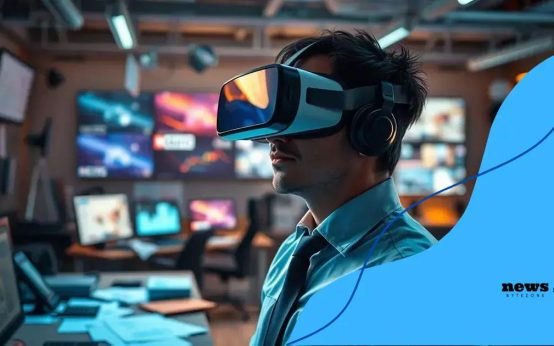The ethics of deepfake technology in modern media raises significant concerns about misinformation, legal challenges, and the impact on public trust, necessitating increased media literacy and updated regulations.
The ethics of deepfake technology in modern media is a topic that lends itself to important discussions about truth and deception. As deepfakes become more accessible, how do they impact our perception of reality and information?
Understanding deepfake technology
Understanding deepfake technology is essential in today’s digital age. In essence, deepfakes use artificial intelligence to create realistic, fabricated media content. This technology can manipulate videos, audio, or images to produce convincing but false representations.
How Deepfakes Work
The core of deepfake technology lies in machine learning algorithms. These algorithms analyze data from real images or audio clips to craft new, altered versions.
- Deep learning networks often use a technique called Generative Adversarial Networks (GANs).
- These networks pit two AIs against each other: one generates fake content, while the other evaluates its authenticity.
- This constant back and forth improves the quality of the generated content.
- As a result, deepfakes can be strikingly realistic.
The Potential Applications
Deepfakes have various applications, some of which can be beneficial. For example, they can be utilized in filmmaking for special effects or in education for training purposes. However, they also pose significant risks.
In recent years, instances of deepfakes have been used to create misleading or harmful content. This raises ethical questions about the authenticity of what we see online. As deepfake technology evolves, so does its potential for misuse.
Individuals, businesses, and lawmakers must remain vigilant to recognize the challenges posed by deepfakes. Understanding the backbone of this technology empowers us to navigate the ethical landscape that surrounds it.
The implications for media integrity
The implications for media integrity are critical in the age of deepfake technology. As deepfakes become more prevalent, the trustworthiness of media comes under scrutiny. This can lead to confusion and misinformation among audiences.
Effects on Public Perception
When the public encounters deepfakes, it can create skepticism towards genuine media content. This skepticism may cause individuals to question the authenticity of news stories and reports.
- Viewers may start to doubt real videos or audio clips.
- It can lead to a decline in trust towards reputable media organizations.
- People might share misinformation without verifying its accuracy.
- This could result in public unrest or misguided opinions on important issues.
Challenges for Journalists
Journalists face unique challenges in the wake of deepfake technology. They must double-check sources and validate the authenticity of the content before sharing.
The need for verification increases their workload, and some may struggle to keep pace with the rapid spread of manipulated media. Journalists also have the responsibility to educate the public about deepfakes and their potential harm.
As technology evolves, media organizations must adapt, using new tools to spot potential deepfakes. This ensures they maintain credibility while providing accurate information to their audiences.
Engagement with audiences through education is also vital. Helping them understand how to identify manipulated content can empower viewers to make informed decisions.
Consequences of misinformation

Consequences of misinformation in today’s world can be severe and wide-ranging. As deepfake technology evolves, the risk of spreading false information increases significantly. This can impact individuals, communities, and society as a whole.
Real-World Impacts
Misinformation can lead to serious repercussions in various areas, such as politics, health, and social relations.
- Political misinformation can sway elections and alter public opinion.
- Health-related misinformation can cause panic or unwarranted distrust in medical professionals.
- Social relationships may suffer as friends and family disagree on false narratives.
- Disinformation campaigns can also lead to violence and civil unrest.
Long-Term Effects
The long-term effects of misinformation can persist long after the initial spread of false information. When people believe in false narratives, it creates a divided society.
This division makes it difficult to reach consensus on critical issues. Debates become polarized, and collaboration on solutions becomes nearly impossible. Furthermore, it erodes trust in legitimate news sources.
In this environment, individuals become more susceptible to believing extreme viewpoints, which can lead to further societal fragmentation. Ultimately, combating misinformation is crucial for maintaining social harmony and progress.
Legal challenges and regulations
Legal challenges and regulations surrounding deepfake technology present a complex landscape. As deepfakes grow in accessibility and accuracy, legal systems struggle to keep up. Balancing innovation with protection is crucial.
Current Legal Framework
In many countries, existing laws do not adequately address the misuse of deepfake technology. Laws regarding copyright, defamation, and fraud often fall short.
- Copyright laws are typically concerned with protecting original works but may not apply to altered content.
- Defamation laws can be difficult to enforce against deepfakes that manipulate an individual’s likeness.
- The potential for fraud with deepfakes complicates legal responses when false information is presented as truth.
- Regulatory frameworks may need to evolve to address these unique challenges.
Proposed Regulations
Experts are suggesting various approaches to regulate deepfake content. Some advocate for establishing clear definitions and classifications for deepfakes. This could help in developing specific laws aimed at misuse.
Additionally, some regions are exploring legislation requiring clear labeling of altered media. This transparency could empower consumers to be more critical of the content they engage with.
Furthermore, creating legal consequences for malicious use is essential. Stricter penalties may deter individuals from creating harmful deepfake content in the first place.
Continuous dialogue among technologists, legal experts, and policymakers is necessary to shape effective regulations that protect society without stifling innovation.
Future of deepfakes in society
The future of deepfakes in society holds both promise and peril. As technology continues to advance, deepfakes will likely become more sophisticated and ubiquitous. Understanding their potential impact helps us navigate this developing landscape.
Advancements in Technology
With the ongoing evolution of artificial intelligence, deepfake technology will improve not only in realism but also in accessibility. This could lead to a wider range of applications.
- In entertainment, deepfakes may revolutionize filmmaking by creating realistic visual effects.
- They could enhance virtual experiences in gaming and education.
- However, the same technology can also be misused in harmful ways.
- As production tools become easier to use, malicious actors may exploit deepfakes for harmful purposes.
Impact on Society
The impact of deepfakes on society is profound. With the rise of altered content, people may struggle to discern truth from fiction. This could lead to increased skepticism towards all forms of media.
Moreover, deepfakes might impact social trust. As friendships and relationships rely on communication, manipulated content could cause misunderstandings. People may hesitate to believe what they see, leading to a culture of doubt.
Education and awareness are key to addressing these challenges. As society grapples with the implications of deepfake technology, promoting media literacy can help individuals better evaluate sources. This will empower users to navigate the complexities of digital content responsibly.
In conclusion, the rise of deepfake technology presents both exciting opportunities and daunting challenges. As we explore the profound implications for media integrity, we must remain vigilant about the consequences of misinformation. Legal frameworks need to evolve to address the unique issues posed by this innovative technology. Ultimately, society must focus on education and awareness to better navigate the future of deepfakes. By promoting media literacy, we can empower individuals to critically evaluate the content they encounter. Engaging in these discussions today will pave the way for a more informed tomorrow.
FAQ – Frequently Asked Questions About Deepfake Technology
What are deepfakes?
Deepfakes are AI-generated content that alters videos or audio to create realistic but fake representations.
How can deepfakes affect media integrity?
Deepfakes can lead to misinformation, causing the public to question the authenticity of genuine media sources.
What are the legal challenges related to deepfakes?
Legal challenges include navigating copyright, defamation, and fraud laws that often do not adequately address deepfake issues.
How can we combat the negative impact of deepfakes?
Improving media literacy and awareness among the public can help individuals critically assess the content they encounter.

 Virtual reality in journalism: immersive storytelling techniques
Virtual reality in journalism: immersive storytelling techniques  The impact of 5G on rural connectivity and development
The impact of 5G on rural connectivity and development  Space tourism: preparing for an amazing journey
Space tourism: preparing for an amazing journey